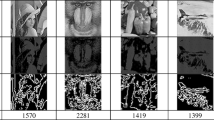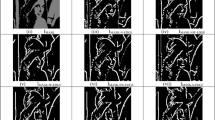Abstract
This paper introduces an edge-based image Steganography scheme in which the pixels of the cover images are categorized into two classes: edge and non-edge. In general, the edge pixels hide more secret bits compared to non-edge pixels due to the following two reasons: noisy nature and high tolerance level. The edge pixels are perceived as noisy due to the variation in intensities with respect to the neighboring pixels and hence it is difficult to model. Further the tolerance level of edge pixels is usually high compared to non-edge pixels on equivalent alteration. These two reasons motivate us to propose a new image Steganography method based on Difference of Gaussians (DoG) Edge detection. The proposed scheme has three major phases: pre-processing cum edge detection, embedding and extraction. In the leading two phases, we obtain the edge image from the cover image and then embed secret bits into the non-edge and edge pixels with X:Y ratio, where for all X, Y, \(1\le \text{X}\le 3 \ \text{and} \ 2\le \text{Y}\le (\text{X}+1)\). In the ultimate phase, we extract the secret bits from the Stego-image. The extracted secret bits helps us to regenerate the secret image which was embedded earlier. The experimental result confirms that the proposed technique offers variable payload and acceptable visual clarity. The comparison results also ensure that the proposed method is superior to the conventional edge detection based Steganography schemes as far as the payload is concerned.





Similar content being viewed by others
References
Atawneh S, Almomani A, Al HB, Sumari P, Gupta B (2017) Secure and imperceptible digital image steganographic algorithm based on diamond encoding in DWT domain. Multimedia Tools Appl 76:18451–18472
Atta R (2018) A high payload steganography mechanism based on Wavelet Packet Transformation. J Vis Commun Image R 53:42–54
Bai J, Chang C, Nguyen C, Liu (2017) A high payload steganographic algorithm based on edge detection. Displays 46:42–51. https://doi.org/10.1016/j.displa.2016.12.004
Bakkouri I, Afdel K (2019) Computer-aided diagnosis (CAD) system based on multi-layer feature fusion network for skin lesion recognition in dermoscopy images. Multimedia Tools Appl 79:20483–20518. https://doi.org/10.1007/s11042-019-07988-1
Bakkouri I, Afdel K (2022) MLCA2F: Multi-level context attentional feature fusion for tablesection COVID-19 lesion segmentation from CT scans. Signal, Image and Video Processing. https://doi.org/10.1007/s11760-022-02325-w
Bender W, Gruhl D, Morimoto N, Lu A (1996) Techniques for data hiding. IBM Syst J 35(3–4):313–336
Boehm B (2014) Stegexpose-A tool for detecting LSB Steganography. arXiv preprint arXiv:1410.6656
Boroumand M, Chen M (2018) Deep residual network for steganalysis of digital images. IEEE Trans Inform Secur 14:1181–1193
Caesar H, Bankiti V, Lang AH, Vora S, Liong VE, Xu Q, Krishnan A, Pan Y, Baldan G, Beijbom O (2019) Nuscenes: a multimodal dataset for autonomous driving. arXiv preprint arXiv:1903.11027
Chandwadkar R, Dhole SP (2013) Comparison of Edge detection techniques. 6th Annual Conference of IRAJ
Chen WJ, Chang CC, Le THN (2010) High payload steganography mechanism using hybrid edge detector. Expert Syst Appl 37:3292–3301
Dhargupta S, Chakraborty A, Ghosal SK, Saha S, Sarkar R (2019) Fuzzy edge detection based steganography using modified gaussian distribution. Multimedia Tools Appl 78(4):17589–17606
Dumitrescu S, Wu X, Memon N (2002) On Steganalysis of random LSB embedding in continuous-tone images. Proceedings International Conference on Image Processing, vol 3, IEEE.
Fridrich J, Goljan M, Dui R (2001) Reliable detection of LSB steganography in color and grayscale images. Proc of the ACM Workshop on Multimedia and Security, pp 27–30
Ghosal SK, Mandal JK (2014) Binomial transform based fragile watermarking for image authentication. J Inf Secur Appl, Elsevier, pp 272–281. https://doi.org/10.1016/j.jisa.2014.07.004
Ghosal SK, Mandal JK, Sarkar R (2018) High payload image steganography based on Laplacian of Gaussian (LoG) edge detector. Multimedia Tools Appl 77. https://doi.org/10.1007/s11042-018-6126-y
Ghosal SK, Chatterjee A, Sarkar R (2021) Image steganography based on Kirsch edge detection. Multimedia Syst 27:73–87. https://doi.org/10.1007/s00530-020-00703-3
Kirsch R (1971) Computer determination of the constituent structure of biological images. Comput Biomed Res 4:315–328
Kumar Gaurav UG (2018) Image Steganography based on canny edge detection, dilation operator and hybrid coding. J Inform Secur Appl 41:41–51. https://doi.org/10.1016/j.jisa.2018.05.001. (ISSN 2214 – 2126)
Kumar S, Singh A, Kumar M (2019) Information hiding with adaptive steganography based on novel fuzzy edge identification. Def Technol 15(2):2214–9147. https://doi.org/10.1016/j.dt.2018.08.003
Kuo WC, Wuu LC, Shyi CN, Kuo SH (2009) A data hiding scheme with high embedding based on general improving exploiting modification direction method. International Conference on Hybrid Intelligent Systems HIS, pp 69–72
Lee CF, Wang YR, Chang CC (2007) A steganographic method with high embedding capacity by improving exploiting modification direction. Proc of the 3rd International Conference on Intelligent Information Hiding and Multimedia Signal Processing Kaohsiung 1:497–500
Lee C-F, Chang, C-C, Tsou P-L (2010) Data hiding scheme with high embedding capacity and good visual quality based on edge detection. 2010 Fourth International Conference on Genetic and Evolutionary Computing
Lei Yang X, Wu D, Zhao H, Li JZ (2011) An improved Prewitt algorithm for edge detection based on noised image. 4th international Congress on Image and Signal Processing, Shanghai, China
Ma X, Li B, Zhang Y, Yan M (2012) The canny edge detection and its improvement. International Conference on Artificial Intelligence and Computational Intelligence, pp 50–58
Mandal JK, Ghosal SK (2012) Separable Discrete Hartley Transform based Invisible Watermarking for Color Image Authentication (SDHTIWCIA). Proc of Springer Second International Conference on Advances in Computing and Information Technology (ACITY2012), pp 767–776
Mathura N, Mathur S, Mathur D (2016) A novel approach to improve Sobel edge detector. Procedia Comput Sci 93:431–438
Matthew JP-H, Thomas JF, Michael WD. Molecular expressions microscopy primer: digital image processing – DoG Edge Enhancement Algorithm. Florida State University, Florida, 32310
Setiadi DRIM (2019) Improved payload capacity in LSB image Steganography uses dilated hybrid edge detection. J King Saud Univ - Comput Inform Sci ISSN 1319–1578. https://doi.org/10.1016/j.jksuci.2019.12.007
Seyyedi SA, Ivanov N (2014) High payload and secure image steganography method based on block partioning and integer wavelet transform. Int J Secur Appl 8:183–194
Shrivakshan GT (2012) A comparison of various Edge detection techniques used in image Processing. IJCSI Int J Comput Sci Issues 9(5):269–276
Tseng HW, Leng HS (2014) High-payload block-based data hiding scheme using hybrid edge detector with minimal distortion. IET Image Process 8:647–654
Wang X (2007) Laplacian operator-based edge detectors. IEEE Trans Pattern Anal Mach Intell 29(5):886–900
Weber AG (1997) “The USC-SIPI, Image Database” Version 5, Signal and Image Processing Institute, University of Southern California, Department of Electrical Engineering, Original release: Oct. http://sipi.usc.edu/database/. Accessed 11 Jul 2019
Wu D-C, Tsai W-H (2003) A steganographic method for images by pixel-value differencing. Pattern Recognit Lett 24(9–10):1613–1626
Xiaojun Qi K, Tanaka KokSheik, Wong (2006) A DCT-based mod 4 steganographic method. Signal Processing” Elsevier, pp 1251–1263
Zhang X, Wang S (2006) Efficient steganographic embedding by exploiting modification direction. IEEE Commun Lett 10(11):1–3
Author information
Authors and Affiliations
Corresponding author
Ethics declarations
Conflict of interest/Competing interests
The authors have no conflicts of interest/Competing interests to declare that are relevant to the content of this article.
Additional information
Publisher’s note
Springer Nature remains neutral with regard to jurisdictional claims in published maps and institutional affiliations.
Rights and permissions
Springer Nature or its licensor (e.g. a society or other partner) holds exclusive rights to this article under a publishing agreement with the author(s) or other rightsholder(s); author self-archiving of the accepted manuscript version of this article is solely governed by the terms of such publishing agreement and applicable law.
About this article
Cite this article
Patwari, B., Nandi, U. & Ghosal, S.K. Image steganography based on difference of Gaussians edge detection. Multimed Tools Appl 82, 43759–43779 (2023). https://doi.org/10.1007/s11042-023-15360-7
Received:
Revised:
Accepted:
Published:
Issue Date:
DOI: https://doi.org/10.1007/s11042-023-15360-7




